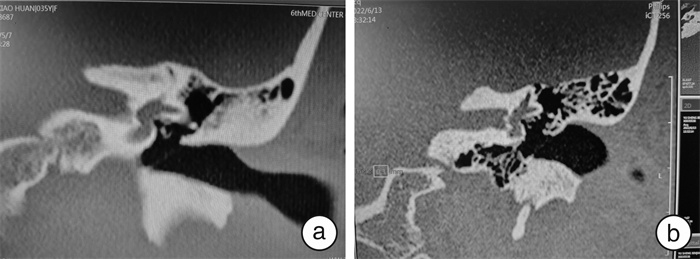-
摘要: 目的 比较耳内镜和显微镜在各种类型的镫骨手术中的应用特点。 方法 分析2020年4月—2023年5月在解放军总医院第六医学中心耳鼻咽喉头颈外科完成的镫骨手术共59台次。通过统计学分析比较耳内镜组与显微镜组在术后听力、术后住院时间、换药次数等方面有无区别。分析因面神经遮窗不能植入人工镫骨的病例,比较2种手术方式的优缺点。 结果 2组患者以耳硬化症为主,其中耳内镜组有1耳(1/23)为中耳畸形,显微镜组有5耳为中耳畸形(5/36),还有2耳为Van Der Hover综合征和4耳为Treacher Collins综合征。耳内镜组10耳(43.5%)术后气骨导差(ABG) ≤10 dB,21耳(91.3%)术后ABG ≤20 dB。显微镜组13耳(41.9%)术后ABG ≤10 dB,28耳(90.3%)术后ABG ≤ 20 dB,2组差异无统计学意义(P>0.05)。耳内镜组术后的复查次数较显微镜组少(P<0.01)。所有患者术后均未出现面瘫、鼓膜穿孔,未出现重度感音神经性听力下降。 结论 对于术前评估镫骨畸形不严重、术中磨骨不多的患者,耳内镜手术较显微镜手术更具有优势,可以减少患者的术后复查次数。对于外耳道狭窄、中耳畸形程度较重的患者,显微镜提供的双手操作环境更利于手术顺利进行。Abstract: Objective To compare the application of endoscope and microscope in all kinds of stapes surgeries. Methods Fifty-nine stapes surgeries have been collected from April 2020 to May 2023 in Senior Department of Otolaryngology Head and Neck Surgery, Chinese PLA General Hospital, Chinese PLA Medical School. Hearing level, hospital stay post-operation, times of hospital visit post-operation, etc. have been compared between the endoscopic group and microscopic group. Patients who were failed to place the stapes prosthesis because of the poor exposure of the oval window have been analyzed. Results Otosclerosis was the most common diagnosis in both groups. There was 1(1/23) middle ear malformation in the endoscopic group and 5(5/36) middle ear malformations in the microscopic group. There were 2 Van Der Hover syndromes and 4 Treacher Collins syndromes in the microscopic group. In the endoscopic group ABG of 10 ears(43.5%) ≤ 10 dB, and ABG of 21 ears(91.3%) ≤20 dB.In the microscopic group ABG of 13 ears(41.9%) ≤ 10 dB, and ABG of 28 ears(90.3%) ≤ 20 dB. There was no statistic difference between 2 groups. Times of hospital visit post-operation in the endoscopic group was less than in the microscopic group(P < 0.01). There was no facial palsy, tympanic perforation or profound sensorineural hearing loss in both groups. Conclusion Endoscope is more suitable for patients who are evaluated with no severe stapes malformation, or less manipulation of drilling the bone. It could also reduce the hospital visit post-operation. Patients with narrow ear canal or severe middle ear malformation are recommended to perform the surgery with microscope, because it provides the chance of manipulation with 2-hands of surgeons.
-
Key words:
- ear endoscopy /
- microscope /
- stapes /
- middle ear malformation /
- hearing
-

-
表 1 耳内镜组和显微镜组患者的诊断、具体类别及手术操作
诊断 耳内镜组 显微镜组 耳数 具体情况 耳数 手术操作 耳数 具体情况 耳数 手术操作 耳硬化症 22 顺利手术 22 PISTON 4.0-4.5 25 顺利手术 23 PISTON 4.0-4.5 遮窗 0 \ 遮窗 2 终止手术 中耳畸形 1 Ⅰ型 1 PISTON 4.25 5 Ⅰ型 1 遮窗,终止手术 Ⅱ型 0 \ Ⅱ型 4 PISTON 7.0 Van Der Hover 综合征 0 \ \ \ 2 顺利手术 2 PISTON 4.5 Treacher Collins 综合征 0 \ \ \ 4 顺利手术 2 PISTON 4.5 外耳道狭窄,遮窗 2 终止手术 “\”代表无此情况。 表 2 耳内镜组与显微镜组镫骨手术后ABG比较
耳 组别 耳数 ≤ 10 dB ≤ 20 dB χ2 P 耳内镜组 23 10 21 0.020 0.990 显微镜组 31* 13 28 *显微镜组共36耳,听力统计去除未行镫骨手术的5耳。 -
[1] 杨琼, 赵宇, 侯昭晖, 等. 内镜下人工镫骨手术安全性和有效性的多中心研究[J]. 中华耳鼻咽喉头颈外科杂志, 2019, 54(4): 262-266.
[2] Bartel R, Sanz JJ, Clemente I, et al. Endoscopic stapes surgery outcomes and complication rates: a systematic review[J]. Eur Arch Otorhinolaryngol, 2021, 278(8): 2673-2679. doi: 10.1007/s00405-020-06388-8
[3] Teunissen EB, Cremers WR. Classification of congenital middle ear anomalies. Report on 144 ears[J]. Ann Otol Rhinol Laryngol, 1993, 102(8 Pt 1): 606-612.
[4] 刘娅, 王辉兵, 赵丹珩, 等. 耳内镜与显微镜在先天性中耳畸形手术中的应用[J]. 中国眼耳鼻喉科杂志, 2023, 23(5): 391-393, 410.
[5] 赵宇, 郑永波, 娄麟, 等. 耳内镜和显微镜下镫骨手术的比较[J]. 中华耳科学杂志, 2017, 15(4): 408-411.
[6] Hajiioannou J, Gkrinia E, Tzimkas-Dakis K, et al. Microscopic versus endoscopic stapes surgery: systematic review and meta-analysis[J]. J Laryngol Otol, 2022, 136(11): 1014-1022. doi: 10.1017/S0022215121004436
[7] Celik T, Erdur O, Gul O, et al. Comparison of endoscopic and microscopic methods in stapedotomy: a retrospective analysis[J]. Eur Arch Otorhinolaryngol, 2023, 280(2): 589-595. doi: 10.1007/s00405-022-07507-3
[8] 刘阳. 鼓膜完整的传导性耳聋相关影像鉴别和治疗策略[J]. 中华耳科学杂志, 2018, 16(1): 122-129.
[9] 吴振恭, 熊俊, 王成龙, 等. 术前颞骨CT扫描影像测量参数预测耳显微外科手术镫骨暴露难易程度的临床价值[J]. 中国耳鼻咽喉颅底外科杂志, 2020, 26(2): 158-162.
[10] Bianconi L, Gazzini L, Laura E, et al. Endoscopic stapedotomy: safety and audiological results in 150 patients[J]. Eur Arch Otorhinolaryngol, 2020, 277(1): 85-92. doi: 10.1007/s00405-019-05688-y
-

| 引用本文: | 刘娅, 王辉兵, 赵丹珩, 等. 耳内镜与显微镜在镫骨手术中的应用分析[J]. 临床耳鼻咽喉头颈外科杂志, 2024, 38(2): 108-111. doi: 10.13201/j.issn.2096-7993.2024.02.005 |
| Citation: | LIU Ya, WANG Huibing, ZHAO Danheng, et al. The application of endoscope and microscope in the stapes surgeries[J]. J Clin Otorhinolaryngol Head Neck Surg, 2024, 38(2): 108-111. doi: 10.13201/j.issn.2096-7993.2024.02.005 |
- Figure 1.




 下载:
下载: